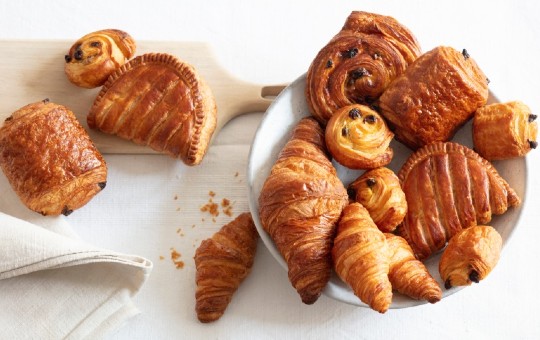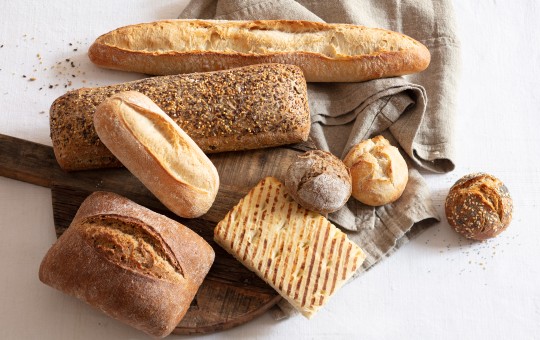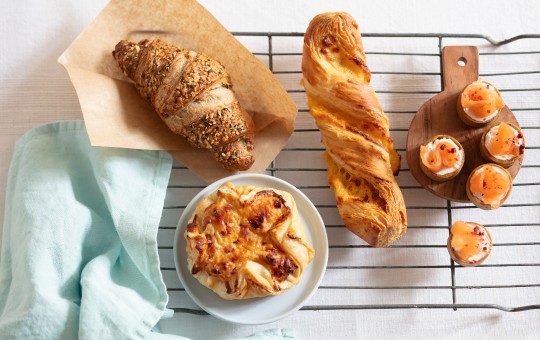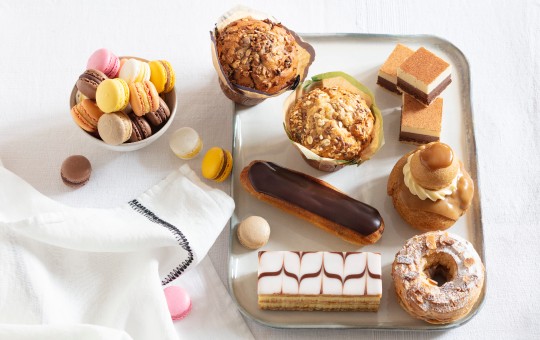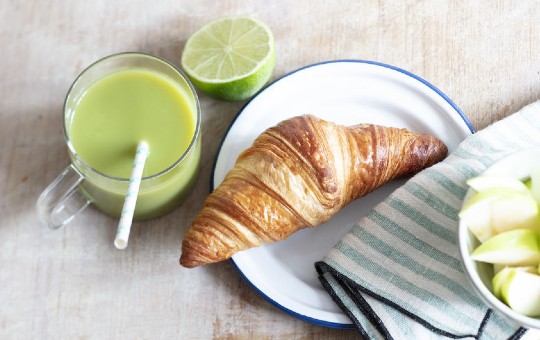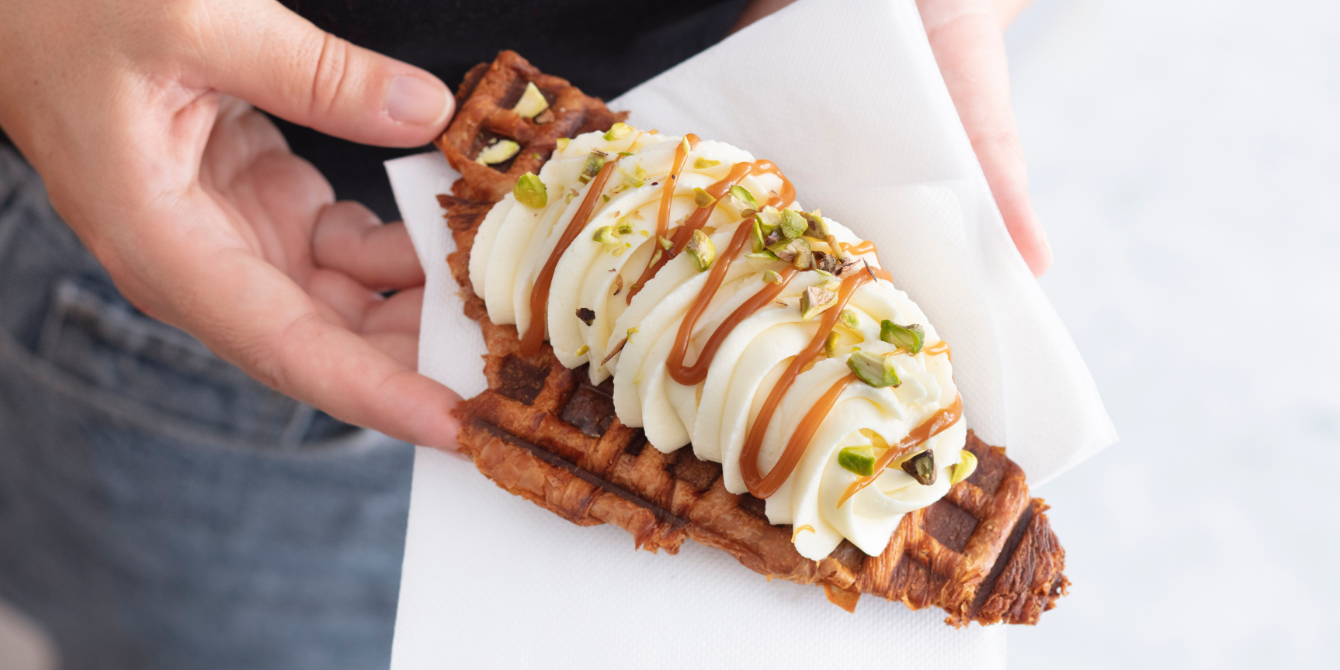
Discover how snacking habits are reshaping the bakery landscape as we explore the latest consumer trends and market insights for 2025.
From morning breaks to evening indulgences, we reveal the evolving patterns that are transforming the way people snack.
Our latest social listening data shows a remarkable surge in consumer interest for bakery products as snacking options, with conversations increasing by 11% and interactions jumping by 38% compared to last year. Viennoiserie leads this transformation with an impressive 356% growth, followed by bread (+71%) and pâtisserie (+57%), while cheese, chocolate, bread rolls, bagels, cakes, desserts and fruits remain top consumer choices1.
From convenience to health consciousness, from meal replacement to social sharing moments, we uncover the 7 key trends driving the snacking revolution in 2025. Learn how these insights can help you adapt your offering and meet evolving consumer demands!
What is a snack? A small definition for a small portion
A snack is a small portion of food that can be enjoyed flexibly throughout the day, whether between main meals or as a meal replacement. Snacks come in diverse forms, from sweet treats like pastries and fruits to savory options such as sandwiches and cheese-based items. They can be wholesome and nutritious, featuring fresh ingredients and whole grains, or more indulgent with rich flavors and texture.
Whether choosing viennoiserie, bread-based items, or healthier alternatives, snacks can be adapted to suit different dietary preferences, portion sizes, and consumption occasions, making them a versatile part of contemporary eating habits.
What are the current snacking trends in the market?
1. All-day snacking: from habit to meal replacement
Snacking is no longer an occasional treat — it has become a central part of the daily eating routine. Consumers now spread their food intake across several smaller moments, driven by changing lifestyles and schedules.
According to Mondelez (2024), 63% of consumers eat at least two snacks per day, and 31% snack three times or more². This shift is especially visible among younger generations who favour flexibility and smaller portions over traditional meals. As a result, snacks increasingly act as meal replacements throughout the day — from morning boosts to afternoon pick-me-ups and even evening indulgences. Notably, 70% of afternoon snackers now actively seek out fresh bakery items, while 52% look for premium options as after-dinner treats².
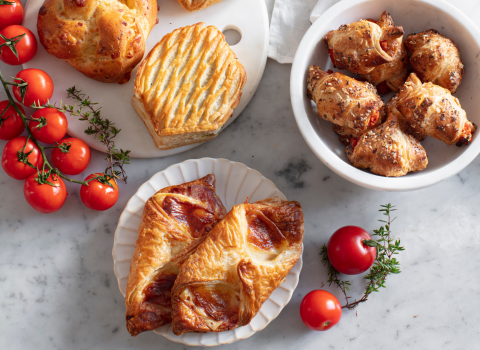

This evolution opens up strong opportunities for bakery players to extend consumption occasions and diversify their offer. Foodservice operators can tailor their ranges to different times of day: think mini-viennoiseries with coffee in the morning, sandwiches or wraps at lunchtime, cookies or sliced cakes in the afternoon, and savoury bites or shareable platters for apéritif. Adapting formats, portion sizes and recipes to fit evolving needs — whether for convenience, indulgence, or nutrition — will be key to capturing these growing snacking moments.
What are the current snacking trends in the market?
1. More than one snack: the multi-snacking revolution
Consumers are no longer limiting themselves to a single snack per day. From a morning energy boost to an afternoon pick-me-up, snacking has become a regular habit throughout the day. This trend reflects a shift in lifestyle, where people snack based on their needs and cravings rather than fixed mealtimes. Recent research from Mondelez (2024) reveals that 63% of consumers now eat at least two snacks per day, while an impressive 31% opt for three daily snacking moments2.
The multi-snacking revolution particularly resonates with younger consumers who prefer frequent, smaller portions over traditional meal structures. This behavioral change suggests a need for varied portion sizes and creative snacking solutions that can be enjoyed at multiple times throughout the day.


This shift in consumption patterns has created new opportunities for bakery businesses to diversify their offer throughout the day. By understanding these evolving habits, foodservice operators can better align their product selection and timing with natural consumer snacking rhythms.
2. A meal replacer: all-day satisfaction


Traditional meal structures are giving way to more flexible eating plan, with snacking emerging as a legitimate meal replacement option. Recent data shows that 62% of consumers now prefer multiple small meals throughout the day instead of fewer large ones, while 58% report greater enjoyment from snacking compared to traditional meals².
The daily rhythm of snacking is evolving, with consumers increasingly turning to bakery products throughout extended hours. Indeed, consumers who snack in the morning are extending their habits to later time slots, driven by evolving workplace schedules and increasing lifestyle flexibility. Research reveals a significant shift in consumer preferences, as 70% of afternoon snackers now specifically seek out fresh bakery items². This presents a clear opportunity for bakeries to extend their peak hours and adapt their product mix to suit different dayparts.
Evening snacking occasions are becoming more sophisticated, with 52% of consumers preferring premium bakery options as after-dinner treats².
This represents a clear opportunity for bakeries to extend their peak hours and adapt their product range to different times of the day. You can therefore offer a specific range depending on the time of day, with mini viennoiseries accompanied by coffee in the morning, a sandwich or wrap at lunchtime, slices of cake or cookies in the afternoon and small portions of savoury snacks or platters to share at aperitif time. This can help you conquer this growing market segment.
2. Work breaks: snacking through the 9-to-5
The workplace has become a central location for daily snacking, with employees increasingly relying on quick snacks to fuel their day, whether it's lunch eaten alone at their desks or informal team breaks. Studies show that most consumers now buy snacks in supermarkets specifically to eat at work³, highlighting a strong demand for convenient and accessible options. Snacks are no longer just a little treat: they have become essential for getting through long working days, combining convenience and comfort and even promoting social interaction.
While this behaviour remains largely influenced by distribution, out-of-home catering has a real opportunity to seize by offering tailor-made solutions. Portion control, both in terms of format (compact, easy to eat) and recipe (innovative, with original, fresh ingredients), is essential. Stand out by offering smart, tailored bundles for every moment of the day, such as:
- Morning combos: a duo with one viennoiseries and a hot drink.
- Lunch to go: salads in jars, wraps or bento boxes ready for delivery or takeaway.
- Afternoon snacks: muffins, protein bites or fruit cups to recharge batteries.
With well-thought-out offerings and takeaway formats, bakeries and food service providers can become indispensable in the workplace.
3. Digital snacking: mastering the multi-channel experience
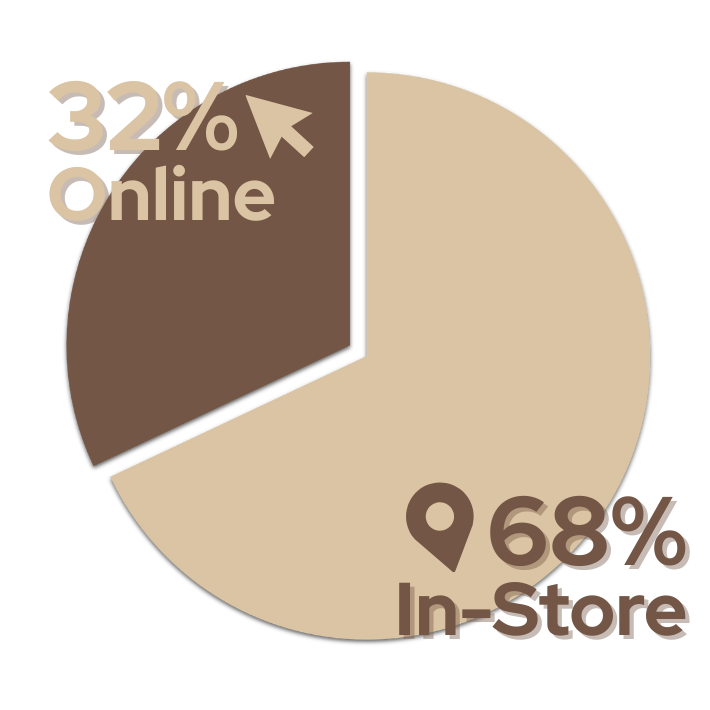

Modern consumers are reshaping purchasing behaviors, balancing digital convenience with traditional shopping experiences. While 68% of consumers plan to maintain in-store purchases for their snacking needs, a significant 32% anticipate shifting towards online platforms².
This dual-channel approach reflects evolving consumer preferences for flexibility in their snacking choices. Physical stores offer immediate gratification and product inspection, while digital platforms provide convenience and time efficiency, particularly for planned purchases and regular favorites.
To stand out in this multi-channel environment, bakeries must ensure a seamless experience across digital and physical touchpoints. Online, eye-catching visuals and contextual product photos (e.g., with coffee or for takeaway) enhance appeal, while clear descriptions and cross-selling tips improve conversion. In-store, well-designed packaging, effective merchandising and consistent branding help attract attention and build trust.
4. Psychosocial factor: beyond physical hunger
The relationship between consumers and snacking extends far beyond mere nourishment, encompassing complex emotional and social dimensions. Recent data reveals that 94% of consumers view snacking as an emotional experience, while 86% consider it physical, and a significant 64% value it as a social sharing moment².
These findings highlight how bakery products serve as powerful catalysts for connection and comfort in daily life. From morning coffee breaks shared with colleagues to afternoon tea moments with friends, snacking creates natural opportunities for social bonding and emotional experience.


Understanding these factors can help to adapt your point of sales & offer to deliver experience beyond product that resonate on multiple level such as shareable formats, inviting spaces for social consumption, aesthetics presentation.
5. A necessity more than a luxury
The economic landscape of 2025 reveals a fascinating paradox in consumer snacking behavior. Despite global financial pressures, snacking has transformed from an occasional indulgence into a daily necessity, with over 60% of consumers maintaining their snack purchases regardless of price changes or shrinkflation over the past two years².
While financial considerations in Western Europe and North America influence product selection, consumers demonstrate remarkable resilience in their snacking habits⁴.
This evolution creates an opportunity for bakery businesses to develop strategic pricing tiers that balance accessibility with quality. Operators can design targeted offers that retain value-seeking customers without compromising on perception. For example, promoting a “4 for 3” deal on bestsellers, offering -50% during the last hour of opening, or creating value bundles for midday or afternoon snacking are smart ways to remain attractive while encouraging repeat purchases. Thoughtful promotions like these can reinforce snacking’s essential role — even in tougher economic times.
6. Balanced lifestyle : between indulgence and consciousness


Consumers are redefining their relationship with snacking, seeking a harmonious balance between indulgence and health consciousness. This changing mindset reflects an understanding of nutrition, where bakery products must meet both pleasure and well-being objectives.
Recent market analysis reveals this nuanced approach: while consumers maintain their daily indulgence in cakes, pastries, and sweet goods for their rich taste, about half now actively choose healthier snacking alternatives. Only 1/4 opt exclusively for indulgent options, signaling a clear shift toward more balanced choices⁴.
Recipes that recorded high interactions are blueberry protein cookie, protein salmon cucumber roll, vegetarian toast sandwich, small cookie balls, mini-pizzas, half-baguette tomato cheese tartine, and many more.
It is true that viennoiserie is the top category considered, but bread-based recipes, mini-sandwiches and healthy recipes where highly voted.¹
This trend shows that it is important to innovate with well thinking recipes, while preserving the essential pleasure of snacking. By adding fruit, incorporating whole grains and offering reasonable portion sizes, operators can meet the emotional needs of discerning, health-conscious consumers.
7. Fast & Easy: quick solutions for modern Life
Technology is revolutionizing snacking habits, with air fryers emerging as the latest kitchen companion for quick bakery preparations.
Social media conversations highlight innovative recipes like air-fried bagel cheese bites and 15-minute baguette rolls gaining significant traction, reflecting a 38% increase in engagement compared to last year¹.
The surge in simple yet creative recipes extends beyond basic toast, with flatbread hummus rolls and instant sandwich variations demonstrating how traditional bakery items adapt to time-pressed lifestyles.




Délifrance, more than a simple In-Store Bakery supplier
Read our full report to discover the lifestyle, motivations, barriers and behaviour of consumers towards the frozen viennoiserie category.
The analysis highlights promising findings that offer exciting opportunities for retailers, while showing how Délifrance's expertise can help you seize them.
References:
At Délifrance, we've been analysing consumer behaviour and sentiment for years. As we do every year, we track consumer changes and adaptations through ongoing research, market research and analysis of online searches and conversations around the world using a variety of tools.
1. Délifrance x Ipsos Synthesio social listening, Snacking, 01/01/2024-19/03/2025 | 2. Mondelez, (2024): State of snacking | 3. Strateg’eat, (2024): Etude speak snacking | 4. Innova market insights, (2024): Consumer Snacking Trends: Exploring Global & Emerging Opportunities

